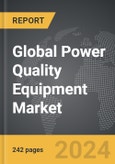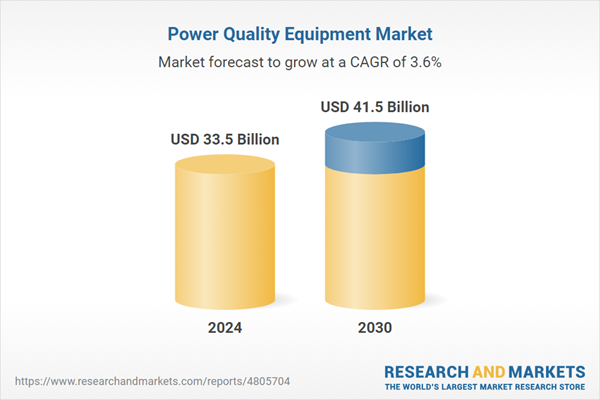The global market for Power Quality Equipment was valued at US$33.5 Billion in 2024 and is projected to reach US$41.5 Billion by 2030, growing at a CAGR of 3.6% from 2024 to 2030. This comprehensive report provides an in-depth analysis of market trends, drivers, and forecasts, helping you make informed business decisions. The report includes the most recent global tariff developments and how they impact the Power Quality Equipment market.
Segments: End-Use Industry (Telecommunications, Electrical & Electronics, Automotive & Industrial, Energy & Utilities, Other End-Use Industries); Equipment (UPS, Harmonic Filters, Surge Protection Devices, Power Conditioning Unit, Static VAR compensator, Power Quality Meters, Other Equipment); Phase (Single, Three Phase).
Geographic Regions/Countries: World; United States; Canada; Japan; China; Europe (France; Germany; Italy; United Kingdom; Spain; Russia; and Rest of Europe); Asia-Pacific (Australia; India; South Korea; and Rest of Asia-Pacific); Latin America (Argentina; Brazil; Mexico; and Rest of Latin America); Middle East (Iran; Israel; Saudi Arabia; United Arab Emirates; and Rest of Middle East); and Africa.
The analysts continuously track trade developments worldwide, drawing insights from leading global economists and over 200 industry and policy institutions, including think tanks, trade organizations, and national economic advisory bodies. This intelligence is integrated into forecasting models to provide timely, data-driven analysis of emerging risks and opportunities.
Global Power Quality Equipment Market - Key Trends and Drivers Summarized
Power Quality Equipment: Ensuring Reliable Electrical Performance
Power quality equipment encompasses devices and systems designed to ensure the reliable delivery of electrical power by mitigating issues such as voltage sags, surges, harmonics, and transient disturbances. These devices are essential for maintaining the integrity and performance of electrical systems in various settings, including industrial, commercial, and residential environments. Key components of power quality equipment include uninterruptible power supplies (UPS), voltage regulators, power conditioners, harmonic filters, and surge protectors. These tools play a critical role in preventing equipment malfunctions, reducing downtime, and safeguarding sensitive electronics from power-related damage. By ensuring stable and clean power, power quality equipment helps enhance operational efficiency, prolongs the lifespan of electrical devices, and reduces maintenance costs, making it indispensable in modern power management strategies.How Are Technological Advancements Enhancing Power Quality Equipment?
Technological advancements have significantly enhanced the capabilities and efficiency of power quality equipment. Innovations in digital signal processing (DSP) and microcontroller technology have improved the accuracy and responsiveness of power monitoring and correction devices. Modern UPS systems, for example, feature advanced battery management and energy storage solutions, providing longer backup times and improved reliability during power outages. Harmonic filters and voltage regulators now incorporate sophisticated control algorithms that adapt to dynamic load conditions, ensuring optimal performance under varying electrical loads. Additionally, the integration of Internet of Things (IoT) technology has enabled real-time monitoring and remote management of power quality equipment, providing users with actionable insights and predictive maintenance capabilities. These advancements have not only increased the effectiveness of power quality solutions but also enhanced their scalability and user-friendliness, making them more accessible and valuable to a broader range of applications.What Are the Key Applications and Benefits of Power Quality Equipment?
Power quality equipment is utilized across diverse industries and applications, offering numerous benefits that enhance electrical system performance and reliability. In industrial settings, these devices protect critical machinery and automation systems from power disturbances, ensuring continuous and efficient production processes. Commercial establishments, such as data centers, hospitals, and office buildings, rely on power quality equipment to safeguard sensitive electronics and IT infrastructure, preventing costly downtime and data loss. In residential environments, surge protectors and voltage regulators enhance the safety and longevity of household appliances and electronic devices. The primary benefits of power quality equipment include improved operational efficiency, reduced maintenance costs, enhanced equipment lifespan, and increased resilience to power disturbances. By providing stable and reliable power, these devices contribute to overall energy efficiency and system reliability, supporting sustainable and uninterrupted operations in various sectors.What Factors Are Driving the Growth in the Power Quality Equipment Market?
The growth in the power quality equipment market is driven by several factors. The increasing dependence on sensitive electronic devices and automation systems in industrial and commercial settings is a significant driver, boosting the demand for reliable power quality solutions. Technological advancements that enhance the performance, efficiency, and connectivity of power quality equipment are also propelling market growth. The rising incidence of power disturbances and the growing awareness of their impact on operational efficiency and equipment longevity are driving the adoption of power quality solutions. Additionally, the expansion of renewable energy sources, which can introduce variability in power supply, is contributing to the need for advanced power quality management. The increasing focus on energy efficiency and sustainability, coupled with regulatory mandates for power quality standards, is further boosting market demand. These factors, combined with the growing availability of innovative and high-quality power quality equipment, are driving the sustained growth of the power quality equipment market.Report Scope
The report analyzes the Power Quality Equipment market, presented in terms of units. The analysis covers the key segments and geographic regions outlined below.Segments: End-Use Industry (Telecommunications, Electrical & Electronics, Automotive & Industrial, Energy & Utilities, Other End-Use Industries); Equipment (UPS, Harmonic Filters, Surge Protection Devices, Power Conditioning Unit, Static VAR compensator, Power Quality Meters, Other Equipment); Phase (Single, Three Phase).
Geographic Regions/Countries: World; United States; Canada; Japan; China; Europe (France; Germany; Italy; United Kingdom; Spain; Russia; and Rest of Europe); Asia-Pacific (Australia; India; South Korea; and Rest of Asia-Pacific); Latin America (Argentina; Brazil; Mexico; and Rest of Latin America); Middle East (Iran; Israel; Saudi Arabia; United Arab Emirates; and Rest of Middle East); and Africa.
Key Insights:
- Market Growth: Understand the significant growth trajectory of the UPS segment, which is expected to reach US$20.5 Billion by 2030 with a CAGR of a 4.3%. The Harmonic Filters segment is also set to grow at 2.9% CAGR over the analysis period.
- Regional Analysis: Gain insights into the U.S. market, valued at $9.6 Billion in 2024, and China, forecasted to grow at an impressive 6.5% CAGR to reach $7.5 Billion by 2030. Discover growth trends in other key regions, including Japan, Canada, Germany, and the Asia-Pacific.
Why You Should Buy This Report:
- Detailed Market Analysis: Access a thorough analysis of the Global Power Quality Equipment Market, covering all major geographic regions and market segments.
- Competitive Insights: Get an overview of the competitive landscape, including the market presence of major players across different geographies.
- Future Trends and Drivers: Understand the key trends and drivers shaping the future of the Global Power Quality Equipment Market.
- Actionable Insights: Benefit from actionable insights that can help you identify new revenue opportunities and make strategic business decisions.
Key Questions Answered:
- How is the Global Power Quality Equipment Market expected to evolve by 2030?
- What are the main drivers and restraints affecting the market?
- Which market segments will grow the most over the forecast period?
- How will market shares for different regions and segments change by 2030?
- Who are the leading players in the market, and what are their prospects?
Report Features:
- Comprehensive Market Data: Independent analysis of annual sales and market forecasts in US$ Million from 2024 to 2030.
- In-Depth Regional Analysis: Detailed insights into key markets, including the U.S., China, Japan, Canada, Europe, Asia-Pacific, Latin America, Middle East, and Africa.
- Company Profiles: Coverage of players such as ABB Group, Active Power, Inc., Acumentrics, Inc., Eaton Corporation PLC, Emerson Electric Co. and more.
- Complimentary Updates: Receive free report updates for one year to keep you informed of the latest market developments.
Some of the 76 companies featured in this Power Quality Equipment market report include:
- ABB Group
- Active Power, Inc.
- Acumentrics, Inc.
- Eaton Corporation PLC
- Emerson Electric Co.
- General Electric Company
- Legrand SA
- Leviton Manufacturing Co., Inc.
- MTE Corporation
- Powervar
- Schneider Electric SA
- Siemens AG
- Smiths Group PLC
- Socomec Group
- Toshiba Corporation
Tariff Impact Analysis: Key Insights for 2025
Global tariff negotiations across 180+ countries are reshaping supply chains, costs, and competitiveness. This report reflects the latest developments as of April 2025 and incorporates forward-looking insights into the market outlook.The analysts continuously track trade developments worldwide, drawing insights from leading global economists and over 200 industry and policy institutions, including think tanks, trade organizations, and national economic advisory bodies. This intelligence is integrated into forecasting models to provide timely, data-driven analysis of emerging risks and opportunities.
What’s Included in This Edition:
- Tariff-adjusted market forecasts by region and segment
- Analysis of cost and supply chain implications by sourcing and trade exposure
- Strategic insights into geographic shifts
Buyers receive a free July 2025 update with:
- Finalized tariff impacts and new trade agreement effects
- Updated projections reflecting global sourcing and cost shifts
- Expanded country-specific coverage across the industry
Table of Contents
I. METHODOLOGYII. EXECUTIVE SUMMARY2. FOCUS ON SELECT PLAYERSIII. MARKET ANALYSISCANADAITALYSPAINRUSSIAREST OF EUROPESOUTH KOREAREST OF ASIA-PACIFICARGENTINABRAZILMEXICOREST OF LATIN AMERICAIRANISRAELSAUDI ARABIAUNITED ARAB EMIRATESREST OF MIDDLE EASTIV. COMPETITION
1. MARKET OVERVIEW
3. MARKET TRENDS & DRIVERS
4. GLOBAL MARKET PERSPECTIVE
UNITED STATES
JAPAN
CHINA
EUROPE
FRANCE
GERMANY
UNITED KINGDOM
ASIA-PACIFIC
AUSTRALIA
INDIA
LATIN AMERICA
MIDDLE EAST
AFRICA
Companies Mentioned (Partial List)
A selection of companies mentioned in this report includes, but is not limited to:
- ABB Group
- Active Power, Inc.
- Acumentrics, Inc.
- Eaton Corporation PLC
- Emerson Electric Co.
- General Electric Company
- Legrand SA
- Leviton Manufacturing Co., Inc.
- MTE Corporation
- Powervar
- Schneider Electric SA
- Siemens AG
- Smiths Group PLC
- Socomec Group
- Toshiba Corporation
Table Information
| Report Attribute | Details |
|---|---|
| No. of Pages | 242 |
| Published | April 2025 |
| Forecast Period | 2024 - 2030 |
| Estimated Market Value ( USD | $ 33.5 Billion |
| Forecasted Market Value ( USD | $ 41.5 Billion |
| Compound Annual Growth Rate | 3.6% |
| Regions Covered | Global |









